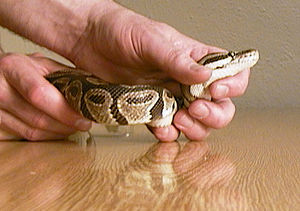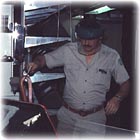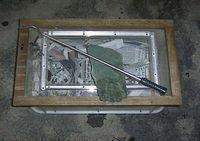Snake Handling and Restraint
| This article has been peer reviewed but is awaiting expert review. If you would like to help with this, please see more information about expert reviewing. |
Physical restraint
Physical or chemical restraint of snakes is frequently required in order to follow safe protocols for a physical examination. The best method for transport of non-venomous and non-aggressive species is simply a cotton bag into which snakes will often retreat voluntarily. Prior to handling any snake it is important to establish the species otherwise dangerous snakes may be inadvertently handled without due care. Ideally snakes should be handled minimally. Hypothermia is not a method of restraint. The oculovasal reflex is not seen in snakes. When handling a snake for the first time it is safest to grasp just behind a snake’s head before lifting the rest of the body.
- Be gentle when handling any snakes.
- Some species must be handled with care, even though they are nonvenomous, since they can be very aggressive. These include reticulated pythons and anacondas.
- Large snakes, such as Burmese pythons, should not be handled by one person alone in case of accident.
- Some snakes may defecate during manual restraint so it is advisable for the vent and lower part of the body to be kept in a bag (e.g. pillow case).
Handling
Nonvenomous snakes should be physically restrained by holding the head at the quadrate/mandible level and supporting the body of the snake. For every three to four feet of snake body, an extra handler should be positioned to support the spine. A snake should never be handled by being placed around the neck of a human. The behaviour of the animal should be observed from a distance prior to grasping. Large constrictors should only be handled when there are two people present. They are extremely powerful and a single handler is in danger of injury, even death. There may also be legal considerations regarding the possession of dangerous animals so ascertain that these are fulfilled.
One-handed technique restraint
Most pet snakes are accustomed to some handling so in many instances restraint can be minimal. While the snake is allowed to grip a wrist and forearm, the hand restrains the snake's head at the base of the skull. The other hand is then free.
Two-handed technique restraint
A snake needs to be supported at a minimum of two points on the body. One person can hold the body and move with the snake as it moves. A second person uses minimal pressure to control the head.
Transportation
Aggressive snakes should be restrained before they are removed from their transportation bag. This is achieved by holding the head behind the occiput using the thumb and middle finger, while the index finger is placed on top of the head. The larger pythons and anacondas can exceed 6m in length and 150kg in weight and are powerful and potentially dangerous. For these animals, a second or even third handler will be required to support the body during the examination. It is usually safer and more convenient to sedate a large pugnacious snake than to struffle on and risk injury to the snake, client or staff.
Equipment
For particularly aggressive or poisonous snakes, clear plastic tubes are very useful. The snake is lifted from its container with a snake hook and placed on the floor. Clear plastic tubing that is just wider than the head of the snake is held in tongs in front of the snake's head. As the snake crawls into the tube, both the tube and the snake are grabbed quickly with the head and upper part of the body within the tube. Openings can be cut into the tube to allow the clinician access to the snake's body for examination or collection of samples. Tubing may not be appropriate for some limber elapids because of the potential for turning within the tubing. Gloves and nooses are best not used because of the potential for unintentional injury.
Venomous snakes
Venomous snakes should obviously only be handled by experienced personnel with appropriate equipment and preferably be treated by experienced veterinarians. Proper identification of any venomous snakes is of the utmost importance, and antivenin should always be readily available. In case of a human bite, it is necessary to have quick access to this antivenin. A veterinarian working with venomous snakes needs to be aware of the laws regarding dangerous animals. Possession of venomous snakes is regulated so make certain that the owner has the appropriate licences. Also check with the appropriate authorities if you, the veterinarian, need to be specially licensed to treat or house venomous snakes.
- At least two people should always be involved in handling a venomous snake
- Large, obvious signs that read "VENOMOUS SNAKE" should be placed on the outside of the enclosure
- An emergency telephone with essential contact numbers should be located nearby of venomous snake enclosures
- An antivenin protocol should be developed with a local hospital
Chemical restraint
Restraint can be induced by parenteral injection of a variety of sedatives. Ketamine is a commonly used dissociative. To facilitate intravenous induction ketamine can be administered by intramuscular injection at 20 mg/kg. This may take up to 30 minutes to take effect. The dosage may be increased up to 50 mg/kg. Diazepam and midazolam (2 mg/kg) have also been advised alone or in combination with ketamine.
- Find out more about anaesthesia in reptiles.
Useful resources


